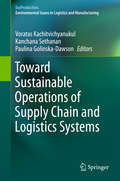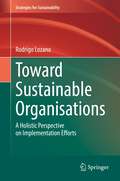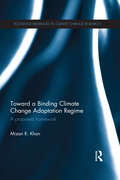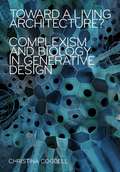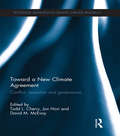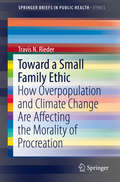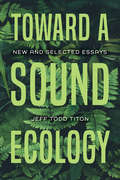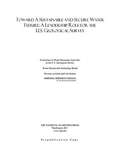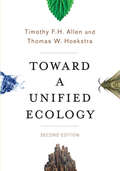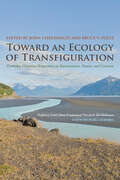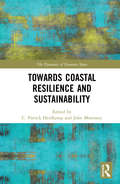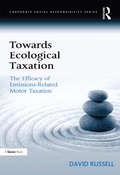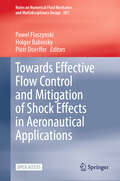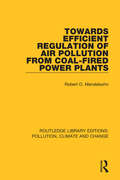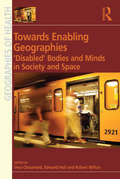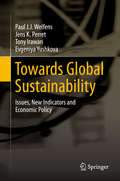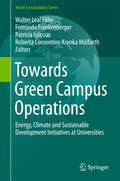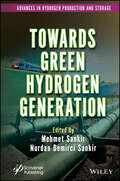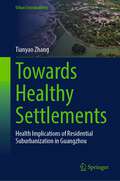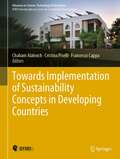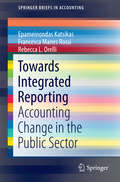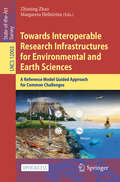- Table View
- List View
Toward Sustainable Operations of Supply Chain and Logistics Systems
by Voratas Kachitvichyanukul Kanchana Sethanan Paulina Golinska-DawsonThis book addresses critical issues in today's logistics operations and supply chain management, with a special focus on sustainability. In dedicated chapters the authors address aspects concerning multimode logistics operations, reverse network configuration, forward and reverse supply chain integration, improvement of the production operations and management of the recovery activities, as well as carbon footprint reduction in transportation. Selected best practices from different countries and industries are presented to aid in the implementation of sustainable policies in private enterprises and at public-sector institutions. The book offers a valuable resource for both academics and practitioners who wish to deepen their expertise in the field of logistics operations and management with regard to sustainability issues. The book examines both qualitative and qualitative aspects of sustainable supply chain and logistics operations.
Toward Sustainable Organisations: A Holistic Perspective on Implementation Efforts (Strategies for Sustainability)
by Rodrigo LozanoThe book is one of the first ones focussing on how organisations (civil society, corporations, and public sector ones) are contributing to sustainability. The book starts by providing a discussion of the four dimensions of sustainability (economic, environmental, social, and time). The second chapter focusses on what organisations are, their system elements (e.g. operations and production, management and strategy, and governance), stakeholders, relationships within and between organisations (ranging from competition to collaboration), and a framework for organisations to understand and map how they can contribute to sustainability. The third chapter discusses the twenty-four main tools, initiatives, and approaches (TIAs) that have been developed for organisations to contribute to sustainability, such as Circular Economy, Corporate Social Responsibility, Environmental Management Systems, and Sustainability Reporting. The fourth chapter focusses on organisational change management for sustainability, including types of change, drivers for change, resistance to change, incorporation, and institutionalisation. The fifth chapter presents empirical evidence on what civil society organisations have contributed to sustainability, from priorities and impacts, TIAs, external stimuli, and internal factors, drivers for change, starts of change, and development of change. The sixth chapter presents empirical evidence on what corporations have contributed to sustainability, from priorities and impacts, TIAs, external stimuli, and internal factors, drivers for change, starts of change, and development of change. The seventh chapter presents empirical evidence on what public sector organisations have contributed to sustainability, from priorities and impacts, TIAs, external stimuli, and internal factors, drivers for change, starts of change, and development of change. The last chapter provides the conclusions of the book.The book is aimed at providing a multi-level, dynamic, and holistic perspective on the contributions of organisations to sustainability. The book's uniqueness lies in analysing organisations’ efforts to become more sustainability oriented and contribute to making societies more sustainable through systems thinking, TIAs, and change processes.
Toward a Binding Climate Change Adaptation Regime: A Proposed Framework (Routledge Advances in Climate Change Research)
by Mizan R. KhanFirst published in 2014. Routledge is an imprint of Taylor & Francis, an informa company.
Toward a Cultural Politics of Climate Change: Devices, Desires and Dissent
by Johannes Stripple Harriet Bulkeley Matthew PatersonTowards a Cultural Politics of Climate Change provides a new perspective on how climate change matters in policy-making, business and everyday life. It argues that the work of low carbon transitions takes place through the creation of devices, the mobilisation of desires, and the articulation of dissent. Using case studies from the US, Australia, and Europe, the book examines the creation and contestation of new forms of cultural politics - of how a climate-changed society is articulated, realized and contested. Through this approach it opens up questions about how, where and by whom climate politics is conducted and the ways in which we might respond differently to this societal challenge. This book provides a key reference point for the emerging academic community working on the cultural politics of climate change, and a means through which to engage this new area of research with the broader social sciences. Develops a new framework for analyzing the cultural politics of climate change, providing readers with a new perspective that bridges accounts of cultural responses to climate change and those which focus on its politics. Includes a range of international case studies which demonstrate the ways in which responses to climate change are being realized in everyday life, giving readers concrete examples from familiar areas of social and political life through which to interpret the new perspective. Provides a new approach to thinking about how climate change comes to matter in everyday life, for those seeking to look beyond 'individualist' approaches to understanding how society is responding to climate change.
Toward a Living Architecture?: Complexism and Biology in Generative Design
by Christina CogdellA bold and unprecedented look at a cutting-edge movement in architectureToward a Living Architecture? is the first book-length critique of the emerging field of generative architecture and its nexus with computation, biology, and complexity. Starting from the assertion that we should take generative architects&’ rhetoric of biology and sustainability seriously, Christina Cogdell examines their claims from the standpoints of the sciences they draw on—complex systems theory, evolutionary theory, genetics and epigenetics, and synthetic biology. She reveals significant disconnects while also pointing to approaches and projects with significant potential for further development. Arguing that architectural design today often only masquerades as sustainable, Cogdell demonstrates how the language of some cutting-edge practitioners and educators can mislead students and clients into thinking they are getting something biological when they are not. In a narrative that moves from the computational toward the biological and from current practice to visionary futures, Cogdell uses life-cycle analysis as a baseline for parsing the material, energetic, and pollution differences between different digital and biological design and construction approaches. Contrary to green-tech sustainability advocates, she questions whether quartzite-based silicon technologies and their reliance on rare earth metals as currently designed are sustainable for much longer, challenging common projections of a computationally designed and manufactured future. Moreover, in critiquing contemporary architecture and science from a historical vantage point, she reveals the similarities between eugenic design of the 1930s and the aims of some generative architects and engineering synthetic biologists today. Each chapter addresses a current architectural school or program while also exploring a distinct aspect of the corresponding scientific language, theory, or practice.No other book critiques generative architecture by evaluating its scientific rhetoric and disjunction from actual scientific theory and practice. Based on the author&’s years of field research in architecture studios and biological labs, this rare, field-building book does no less than definitively, unsparingly explain the role of the natural sciences within contemporary architecture.
Toward a New Climate Agreement: Conflict, Resolution and Governance (Routledge Advances in Climate Change Research)
by Jon Hovi David M. McEvoy Todd L. CherryClimate change is one of the most pressing problems facing the global community. Although most states agree that climate change is occurring and is at least partly the result of humans’ reliance on fossil fuels, managing a changing global climate is a formidable challenge. Underlying this challenge is the fact that states are sovereign, governed by their own laws and regulations. Sovereignty requires that states address global problems such as climate change on a voluntary basis, by negotiating international agreements. Despite a consensus on the need for global action, many questions remain concerning how a meaningful international climate agreement can be realized. This book brings together leading experts to speak to such questions and to offer promising ideas for the path toward a new climate agreement. Organized in three main parts, it examines the potential for meaningful climate cooperation. Part 1 explores sources of conflict that lead to barriers to an effective climate agreement. Part 2 investigates how different processes influence states’ prospects of resolving their differences and of reaching a climate agreement that is more effective than the current Kyoto Protocol. Finally, part 3 focuses on governance issues, including lessons learned from existing institutional structures. The book is unique in that it brings together the voices of experts from many disciplines, such as economics, political science, international law, and natural science. The authors are academics, practitioners, consultants and advisors. Contributions draw on a variety of methods, and include both theoretical and empirical studies. The book should be of interest to scholars and graduate students in the fields of economics, political science, environmental law, natural resources, earth sciences, sustainability, and many others. It is directly relevant for policy makers, stakeholders and climate change negotiators, offering insights into the role of uncertainty, fairness, policy linkage, burden sharing and alternative institutional designs.
Toward a Small Family Ethic
by Travis N. N. RiederThis thought-provoking treatise argues that current human fertility rates are fueling a public health crisis that is at once local and global. Its analysis and data summarize the ecological costs of having children, presenting ethical dilemmas for prospective parents in an era of competition for scarce resources, huge disparities of wealth and poverty, and unsustainable practices putting irreparable stress on the planet. Questions of individual responsibility and integrity as well as personal moral and procreative issues are examined carefully against larger and more long-range concerns. The author's assertion that even modest efforts toward reducing global fertility rates would help curb carbon emissions, slow rising global temperatures, and forestall large-scale climate disaster is well reasoned and more than plausible. Among the topics covered: · The multiplier effect: food, water, energy, and climate. · The role of population in mitigating climate change. · The carbon legacy of procreation. · Obligations to our possible children. · Rights, what is right, and the right to do wrong. · The moral burden to have small families. Toward a Small Family Ethic sounds a clarion call for bioethics students and working bioethicists. This brief, thought-rich volume steers readers toward challenges that need to be met, and consequences that will need to be addressed if they are not.
Toward a Sound Ecology: New and Selected Essays (Music, Nature, Place)
by Jeff Todd TitonHow does sound ecology—an acoustic connective tissue among communities—also become a basis for a healthy economy and a just community? Jeff Todd Titon's lived experiences shed light on the power of song, the ecology of musical cultures, and even cultural sustainability and resilience. In Toward a Sound Ecology, Titon's collected essays address his growing concerns with people making music, holistic ecological approaches to music, and sacred transformations of sound. Titon also demonstrates how to conduct socially responsible fieldwork and compose engaging and accessible ethnography that speaks to a diverse readership. Toward a Sound Ecology is an anthology of Titon's key writings, which are situated chronologically within three particular areas of interest: fieldwork, cultural and musical sustainability, and sound ecology. According to Titon—a foundational figure in folklore and ethnomusicology—a re-orientation away from a world of texts and objects and toward a world of sound connections will reveal the basis of a universal kinship.
Toward a Sustainable and Secure Water Future: A Leadership Role for the U.S. Geological Survey
by National Research Council of the National AcademiesWater is our most fundamental natural resource, a resource that is limited. Challenges to our nation's water resources continue to grow, driven by population growth, ecological needs, climate change, and other pressures. The nation needs more and improved water science and information to meet these challenges. Toward a Sustainable and Secure Water Future reviews the United States Geological Survey's (USGS) Water Resource Discipline (WRD), one of the nation's foremost water science organizations. This book provides constructive advice to help the WRD meet the nation's water needs over the coming decades. Of interest primarily to the leadership of the USGS WRD, many findings and recommendations also target the USGS leadership and the Department of Interior (DOI), because their support is necessary for the WRD to respond to the water needs of the nation.
Toward a Unified Ecology (Complexity in Ecological Systems)
by Timothy Allen Thomas HoekstraThe first edition of Toward a Unified Ecology was ahead of its time. For the second edition, the authors present a new synthesis of their core ideas on evaluating communities, organisms, populations, biomes, models, and management. The book now places greater emphasis on post-normal critiques, cognizant of ever-present observer values in the system. The problem it addresses is how to work holistically on complex things that cannot be defined, and this book continues to build an approach to the problem of scaling in ecosystems. Provoked by complexity theory, the authors add a whole new chapter on the central role of narrative in science and how models improve them. The book takes data and modeling seriously, with a sophisticated philosophy of science.
Toward an Ecology of Transfiguration: Orthodox Christian Perspectives on Environment, Nature, and Creation (Orthodox Christianity and Contemporary Thought)
by John Chryssavgis and Bruce V. FoltzCan Orthodox Christianity offer spiritual resources uniquely suited to the environmental concerns of today? This book makes the case emphatically that it can indeed. In addition to being the first substantial and comprehensive collection of essays, in any language, to address environmental issues from the Orthodox point of view, this volume (with contributions from many of the most influential theologians and philosophers in contemporary world Orthodoxy) will engage a wide audience, in academic as well as popular circles—resonating not only with Orthodox audiences but with all those in search of a fresh approach to environmental theory and ethics that can bring to bear the resources of ancient spirituality, often virtually unknown in the West, on modern challenges and dilemmas.
Towards Coastal Resilience and Sustainability (The Dynamics of Economic Space)
by John Morrissey C. Patrick HeidkampCoastal zones represent a frontline in the battle for sustainability, as coastal communities face unprecedented economic challenges. Coastal ecosystems are subject to overuse, loss of resilience and increased vulnerability. This book aims to interrogate the multi- scalar complexities in creating a more sustainable coastal zone. Sustainability transitions are geographical processes, which happen in situated, particular places. However, much contemporary discussion of transition is either aspatial or based on implicit assumptions about spatial homogeneity. This book addresses these limitations through an examination of socio- technological transitions with an explicitly spatial focus in the context of the coastal zone. The book begins by focusing on theoretical understandings of transition processes specific to the coastal zone and includes detailed empirical case studies. The second half of the book appraises governance initiatives in coastal zones and their efficacy. The authors conclude with an implicit theme of social and environmental justice in coastal sustainability transitions. Research will be of interest to practitioners, academics and decision- makers active in the sphere of coastal sustainability. The multi- disciplinary nature encourages accessibility for individuals working in the fields of Economic Geography, Regional Development, Public Policy and Planning, Environmental Studies, Social Geography and Sociology.
Towards Ecological Taxation: The Efficacy of Emissions-Related Motor Taxation (Corporate Social Responsibility)
by David RussellGovernments around the world are struggling to meet their commitments to achieve targets relating to reductions in greenhouse gases. Many writers advocating ways to achieve these targets offer radical but often impractical approaches that do not offer a way forward within the existing economic model. In contrast, Towards Ecological Taxation is a pragmatic consideration of realistic possibilities by an author from the world of accounting. Based on his research into the implications of changes in the UK motor taxation regime for company cars, David Russell considers the broader efficacy of taxation policy as a mechanism for reducing demand for fossil fuels and encouraging a shift towards carbon-neutral energy production. He incorporates the findings of a number of studies into his analysis, along with a wider consideration of tax regimes. Dr Russell suggests a way forward that will attract the interest of researchers, policy makers and decision makers wanting a better understanding of how taxation could be used innovatively, but within the existing economic status quo, to deliver specific and measurable reductions in CO2. Such a distinctive approach makes this book a valuable addition to the literature on environmental issues and the always thought provoking titles in the Corporate Social Responsibility Series.
Towards Effective Flow Control and Mitigation of Shock Effects in Aeronautical Applications (Notes on Numerical Fluid Mechanics and Multidisciplinary Design #201)
by Holger Babinsky Piotr Doerffer Pawel FlaszynskiThis open-access book reports on both experimental and numerical findings from the H2020-funded project TEAMAero (Towards Effective Flow Control and Mitigation of Shock Effects in Aeronautical Applications). It covers novel contributions on improving the fundamental understanding of the physics of shock wave boundary layer interaction, developments in flow control for mitigation of shock effects, and advanced numerical methods for predicting those effects. All in all, this book offers a timely snapshot of research and developments in numerical methods for flow analysis and control, with a special emphasis on high-speed flows. It offers extensive information to both researchers and professionals.
Towards Efficient Regulation of Air Pollution from Coal-Fired Power Plants
by Robert O. MendelsohnOriginally published in 1979, this book discusses the model developed to deal with air pollution from coal fired power plants, but it broadly also illustrates how available scientific information can be organized to improve our understanding of pollution control. This information enables economists to discuss the relevant consequences of specific air pollution abatement strategies. In order to demonstrate the usefulness of a computer based environmental model, the model is applied to a specific case study. The object of the case study is the control of air pollution from a coal-fired, electrical generating station in New Haven, USA. The research contained in this volume advances applied risk analysis by combining the insights of economics and environmental sciences.
Towards Enabling Geographies: ‘Disabled’ Bodies and Minds in Society and Space (Geographies of Health Series)
by Edward HallOver the past 15 years, geography has made many significant contributions to our understanding of disabled people's identities, lives, and place in society and space. 'Towards Enabling Geographies' brings together leading scholars to showcase the 'second wave' of geographical studies concerned with disability and embodied differences. This area has broadened and challenged conventional boundaries of 'disability', expanding the kinds of embodied differences considered, while continuing to grapple with important challenges such as policy relevance and the use of more inclusionary research approaches. This book demonstrates the value of a spatial conceptualization of disability and disablement to a broader social science audience, whilst examining how this conceptualization can be further developed and refined.
Towards Equitable Progress: Essays from a South Asian Perspective (South Asia Economic and Policy Studies)
by K. Locana GunaratnaThis book gathers a collection of essays presented from the perspective of a spatial planner whose working life has been immersed in South Asia. It concerns some of the serious challenges that need to be confronted in the South Asian context, including the externalities and ethical concerns that arise in the process of development. The mid-20th century saw a considerable focus in the West on assisting those countries emerging from European colonial domination. Theories were propounded and international agencies established to facilitate a process called ‘development’ in these countries. However, even after six decades of extraordinary expenditures and effort, millions among the targeted populations remain illiterate, live in abject poverty, and are the most vulnerable groups to external disasters, debilitating diseases and untimely death. In addition, the book reveals the theoretical inadequacies that negatively impact ongoing development efforts. Lastly, it identifies an available alternative set of science-based approaches that could facilitate the serious pursuit of equitable progress in South Asia and potentially also in other low and middle income countries.
Towards Global Sustainability
by Paul J. J. Welfens Jens K. Perret Tony Irawan Evgeniya YushkovaThis study develops a new indicator for national and global sustainability. The main components of the EIIW-vita indicator are: the share of renewable energy, the genuine savings rate and the relative "green export" position of the respective countries; it is in line with OECD requirements on composite indicators. As green exports are related to technological progress and environmental-friendly products, there is also a Schumpeterian perspective of this indicator. An extended version furthermore looks at water productivity. The analysis highlights the BRIICS countries as well as the US, Germany, France, Spain, Italy, the UK and Japan. Moreover the special challenges and dynamics of ASEAN countries and Asia are discussed. The book derives key implications for economic and environmental policy and shows that the new global sustainability indicator is not only relevant for green progress, but also useful as a signal for international investors. The construction of the EIIW-vita global sustainability indicator is such that investors, citizens and governments can easily interpret the results. Correlation analysis of the new sustainability indicator with the human development index indicates complementarity, so that a new hybrid superindicator can be constructed. Sustainability rhetoric dominates environmental policy. This fresh assessment of key "pillars" of sustainable economic performance and growth is a valuable contribution to greening the economy, the leitmotiv of the latest Rio Earth Summit. The book places the discussion of sustainability on solid data. The rather surprising results of its new sustainability index should make policy makers rethink their environmental and economic strategies. Prof. Dr. Peter Bartelmus Columbia University, New York Many people put the economy first when sustainability concerns are raised, while environmental indicators are often developed without a sense of socio-economic performance. This important new book bridges the gap. It sheds light on crucial indicators such as renewable energies, exporting green goods and services, genuine savings, and water productivity. And it helps to observe the impressive changes at a global scale and in countries such as China. A must read for all experts interested in those issues. Prof. Dr. Raimund Bleischwitz University College London
Towards Green Campus Operations: Energy, Climate And Sustainable Development Initiatives At Universities (World Sustainability Series)
by Walter Leal Filho Fernanda Frankenberger Patricia Iglecias Roberta Consentino Kronka MülfarthMatters related to sustainable development, albeit global in nature, are best handled at the local level. This line of thinking is particularly true to the higher education context, where the design and implementation of sustainability initiatives on campuses can demonstrate how a given university translates the principles of sustainable development into practice, at the institutional level. Yet, there is a paucity of specific events where a dialogue among sustainability academics and practitioners concerned with a) research, projects b) teaching and c) planning and infra-structure leading to campus greening takes place, so as to allow a transdisciplinary and cross-sectoral exchange of ideas and experiences on the issues, matters and problems at hand. It is against this background that this book has been prepared. It is one of the outcomes of the “First Symposium on Sustainability in University Campuses” (SSUC-2017) organised by the University of São Paulo in Brazil, Manchester Metropolitan University (UK), the Research and Transfer Centre “Applications of Life Sciences” of the Hamburg University of Applied Sciences (Germany), and the Inter-University Sustainable Development Research Programme (IUSDRP). This book showcases examples of campus-based research and teaching projects, regenerative campus design, low-carbon and zero carbon buildings, waste prevention, and resilient transport, among others. It also demonstrates the role of campuses as platforms for transformative social learning and research, and explores the means via which university campuses can be made more sustainable. The aims of this publication are as follows: i. to provide universities with an opportunity to obtain information on campus greening and sustainable campus development initiatives from round the world; ii. to document and promote information, ideas and experiences acquired in the execution of research, teaching and projects on campus greening and design, especially successful initiatives and good practice; iii. to introduce methodological approaches and projects which aim to integrate the topic of sustainable development in campus design and operations. This book entails contributions from researchers and practitioners in the field of campus greening and sustainable development in the widest sense, from business and economics, to arts, administration and environment.
Towards Green Hydrogen Generation (Advances in Hydrogen Production and Storage (AHPS))
by Mehmet Sankir Nurdan Demirci SankirReaders will find a multidisciplinary approach elucidating all the important features of green hydrogen so that science researchers and energy engineers as well as those in economics, political science and international relations, will also find value. Energy sources and generation is the foremost concern of all governments, NGOs, and activist groups. With Green New Deals and reduced or net zero emission goals being implemented on a global scale, the quest for economic, scalable, efficient, and sustainable energy systems has reached a fever pitch. No one energy source ticks all the boxes and new energy technologies are being developed all the time as potential disruptors. Enter green hydrogen with zero emissions. Hydrogen is a rare gas in nature and is often found together with natural gas. While hydrogen is the most abundant element in the known universe, molecular hydrogen is very rare in nature and needs to be produced—and produced in large quantities, if we are serious about the Green Deal. This book has been organized into three parts to introduce and discuss these crucial topics. Part I discusses the Green Deal and the current state and challenges encountered in the industrialization of green hydrogen production, as well as related politics. Chapters in this section include how to decarbonize the energy industry with green hydrogen, and one that describes a gradual shift in the approach of hydrogen production technologies from non-renewable to renewable. Part II is devoted to carbon capturing and hydrogen. Chapters on biomass mass waste-to-hydrogen conversion and related efficient and sustainable hydrogen storage pathways, life cycle assessment for eco-design of biohydrogen factory by microalgae, and metal oxide-based carbon capture technologies are all addressed in this section. The third and final part of the book was designed to present all features of green hydrogen generation. Chapters include PEM water electrolysis and other electrolyzers, wind-driven hydrogen production, and bifunctional electrocatalysts-driven hybrid water splitting, are introduced and thoroughly discussed. Audience This book is directed to researchers and industry professionals in energy engineering, chemistry, physics, materials science, and chemical engineering, as well as energy policymakers, energy economists, and others in the social sciences.
Towards Healthy Settlements: Health Implications of Residential Suburbanization in Guangzhou (Urban Sustainability)
by Tianyao ZhangThis book aims to formulate recommendations for achieving a healthy neighborhood living environment for the middle-income people in China‘s suburbs. In China, the expeditious urbanization triggers the prosperous commodity housing development, which further grows with the spatial restructuring and socioeconomic transition. Residential suburbanization is generated, accompanied with the emergence of new-middle class and the change of lifestyle. However, the health effects of suburbanization in China are overlooked. This book investigates the health performance of suburban residents and the effects of suburban living on residents‘ health. This book also examines the resident-environment transaction modes to unfold the underlying mechanism of suburban living affecting residents’ health. Suburban residents had to passively adapt to their residential environment, which is the obstacle for achieving a health-promoting environment. The institutional dynamics determining the health performance of suburban living environment were addressed with the roles of governments, developers, planners, housing managers, residents‘ committee, and ordinary residents in commodity housing development. The book found no institutional support for the creation of health-promoting environments, especially with default of governments and excessive dependence on developers for public service facilities and the absence of civil society. Thus, the book proposes that institutional innovations are necessary in term of embedding the health dimension in all sectors of the society, enlisting collaboration between public and private sectors, and between health and non-health sectors, and thus cultivating the optimization of residents-environment transactions to create health-promoting environments.
Towards Implementation of Sustainability Concepts in Developing Countries (Advances in Science, Technology & Innovation)
by Chaham Alalouch Cristina Piselli Francesco CappaThis book focuses on sustainability concepts in architecture and urban design, environmental issues, and natural resources. Today it has become essential to reduce carbon emissions, protect habitats, and preserve the delicate ecosystems of our planet. Accordingly, sustainable development has to be improved by decreasing the consumption of non-renewable resources, in order to help nature replenish itself.Further, it highlights the efforts that have been made by architects, environmentalists, engineers, students, planners and everyone in between in order to improve sustainability in various developing communities and countries.
Towards Infrared Finite S-matrix in Quantum Field Theory (Springer Theses)
by Hayato HiraiThis book presents the better understanding of infrared structures of particle scattering processes in quantum electrodynamics (QED) in four-dimensional spacetime. An S-matrix is the fundamental quantity in scattering theory. However, if a theory involves massless particles, such as QED and gravity, the conventional S-matrix has not been well defined due to the infrared divergence, and infrared dynamics thus needs to be understood in-depth to figure out the S-matrix. The book begins with introducing fundamental nature of the charge conservation law associated with asymptotic symmetry, and explaining its relations to soft theorems and memory effect. Subsequently it looks into an appropriate asymptotic state of the S-matrix without infrared divergences. The Faddeev-Kulish dressed state is known as a candidate of such a state, and its gauge invariant condition and its relation to the asymptotic symmetry are discussed. It offers an important building blocks for constructing the S-matrix without infrared divergences.
Towards Integrated Reporting: Accounting Change in the Public Sector (SpringerBriefs in Accounting)
by Epameinondas Katsikas Rebecca L. Orelli Francesca Manes RossiThis book focuses on the accounting change processes that drive integrated reporting in the public sector. The Integrated Report is a tool that allows public sector entities to quantify and convey those aspects of their organization, strategy, governance and performance that lead to the creation of public value over time. To be successfully introduced, integrated reporting must follow a specific path of accounting change. The context in which public sector entities operate, and the unique relationship between the public sector and the environment, redefine the accounting process of change to deliver an integrated report. The authors provide a fresh look at integrated reporting on the basis of the accounting change processes that drive it, helping academics and practitioners to gain a deeper understanding of the challenges and benefits in terms of public value creation.
Towards Interoperable Research Infrastructures for Environmental and Earth Sciences: A Reference Model Guided Approach for Common Challenges (Lecture Notes in Computer Science #12003)
by Zhiming Zhao Margareta HellströmThis open access book summarises the latest developments on data management in the EU H2020 ENVRIplus project, which brought together more than 20 environmental and Earth science research infrastructures into a single community. It provides readers with a systematic overview of the common challenges faced by research infrastructures and how a ‘reference model guided’ engineering approach can be used to achieve greater interoperability among such infrastructures in the environmental and earth sciences. The 20 contributions in this book are structured in 5 parts on the design, development, deployment, operation and use of research infrastructures. Part one provides an overview of the state of the art of research infrastructure and relevant e-Infrastructure technologies, part two discusses the reference model guided engineering approach, the third part presents the software and tools developed for common data management challenges, the fourth part demonstrates the software via several use cases, and the last part discusses the sustainability and future directions.
